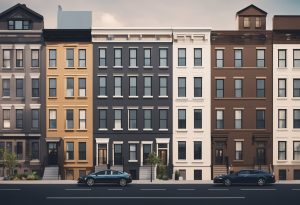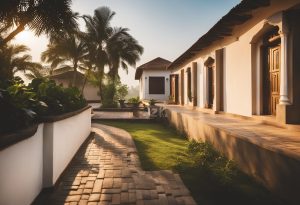South-facing houses have been a topic of debate for many years. Is a south-facing house good or bad? There are many myths and beliefs that surround them. Some people believe that south-facing houses bring bad luck and negative energy, while others believe that they are auspicious and bring positive energy. The question remains: is a south-facing house good or bad?
According to Vastu Shastra, a south-facing house is considered auspicious and brings positive energy. However, it can also have some drawbacks such as dosha, financial problems, relationship issues, and negative energy. The position of the main entrance, the location of the kitchen, and the placement of the bedrooms are some of the factors that can affect the energy flow in a south-facing house.
Despite the beliefs and myths surrounding south-facing houses, it is important to understand that the orientation of a house is not the only factor that determines its energy flow. The layout, design, and placement of objects inside the house also play a significant role. Therefore, it is important to consult a Vastu expert who can guide you on how to balance the pros and cons of a south-facing house with Vastu principles.
Benefits of South Facing Houses
South facing houses have been a topic of debate in Vastu Shastra for a long time. However, contrary to popular belief, south facing houses have many benefits that make them an excellent choice for homeowners. In this section, we will discuss some of the benefits of south facing houses.
Enhanced Natural Light
One of the most significant benefits of a south facing house is the abundant natural light that it receives. South facing homes get more sunlight throughout the day, making them brighter and more cheerful. This is especially true for the living room and bedrooms, which are the most frequently used spaces in a home. The increased natural light also helps to reduce the need for artificial lighting, which can result in energy savings.
Energy Efficiency and Savings
South facing houses are known for their energy efficiency. They receive more sunlight, which helps to keep the home warmer during the winter months. This results in lower heating bills and reduced energy consumption. Additionally, the orientation of a south facing house allows for better ventilation, which helps to keep the home cool during the summer months. This results in lower cooling bills and reduced energy consumption.
Garden and Plant Growth
If you are a gardening enthusiast, then a south facing house is an excellent choice for you. The abundance of sunlight that south facing houses receive is perfect for growing plants and vegetables. The orientation of a south facing house allows for a more extended growing season and better plant growth. Additionally, the increased natural light helps to reduce the need for artificial lighting in indoor gardens, resulting in energy savings.
Psychological and Health Advantages
South facing houses are known to have psychological and health advantages. The abundance of natural light that south facing houses receive has been linked to improved mood, increased productivity, and better sleep quality. Additionally, the increased natural light helps to reduce the risk of vitamin D deficiency, which is essential for healthy bone growth and development.
In conclusion, south facing houses have many benefits that make them an excellent choice for homeowners. From enhanced natural light to energy efficiency and savings, garden and plant growth to psychological and health advantages, there are many reasons why you should consider a south facing house as your next home.
Potential Drawbacks of South Facing Houses
While a south-facing house is generally considered to be auspicious and attract positive energy according to Vastu principles, there are some potential drawbacks to consider as well. In this section, we will discuss some of these drawbacks.
Overheating Risks
One of the main concerns with a south-facing house is the risk of overheating, especially during the summer months. The house receives direct sunlight throughout the day, which can lead to a buildup of heat inside. This can make the house uncomfortable to live in, and also increase the need for air conditioning, which in turn can lead to higher energy bills.
To mitigate this risk, it is important to ensure that the house is properly insulated and has adequate ventilation. This can help to regulate the temperature inside the house and prevent it from becoming too hot.
Glare and Light Control
Another potential drawback of a south-facing house is the issue of glare and light control. The house receives direct sunlight throughout the day, which can create glare and make it difficult to see inside. This can be especially problematic if the house has large windows or is located in an area with a lot of sunlight.
To address this issue, it is important to use appropriate window treatments, such as blinds or curtains, to control the amount of light entering the house. This can help to reduce glare and make it more comfortable to live in.
Seasonal Variations
Finally, it is worth noting that the benefits of a south-facing house can vary depending on the season. While the house may receive ample sunlight during the winter months, it can become too hot during the summer. Additionally, the angle of the sun changes throughout the year, which can affect the amount of sunlight that the house receives.
To address these seasonal variations, it may be necessary to make adjustments to the house, such as adding shading devices or changing the orientation of the windows. This can help to ensure that the house remains comfortable and energy-efficient throughout the year.
Architectural Considerations of South Facing Houses
When it comes to designing and constructing a South-facing house, there are several architectural considerations that need to be taken into account. These considerations can help ensure that the house is comfortable, energy-efficient, and aesthetically pleasing.
Window Placement and Size
One of the most important architectural considerations for a South-facing house is window placement and size. South-facing windows can provide ample natural light and warmth, but they can also allow too much heat to enter the house during the summer months. To mitigate this, architects may recommend placing windows higher up on the wall or using overhangs to block direct sunlight.
The size of the windows is also important. Large windows can provide more natural light and ventilation, but they can also result in higher energy bills due to heat loss in the winter and heat gain in the summer. Architects may recommend using double-glazed windows or installing shading devices to help regulate the amount of heat and light that enters the house.
Insulation and Materials
Another important consideration for a South-facing house is insulation and materials. Proper insulation can help regulate the temperature inside the house, reducing the need for heating and cooling systems. Architects may recommend using materials with high thermal mass, such as brick or concrete, to help absorb and store heat during the day and release it at night.
The orientation of the house can also affect insulation and materials. For example, a South-facing house in a hot climate may require more insulation and shading devices than a South-facing house in a cooler climate.
Shading Solutions
Shading solutions are another important consideration for a South-facing house. Shading devices such as awnings, blinds, and shutters can help regulate the amount of light and heat that enters the house, reducing the need for artificial cooling systems. Architects may recommend using shading devices that can be adjusted throughout the day to account for changes in the sun’s position.
Overall, designing and constructing a South-facing house requires careful consideration of several architectural factors. By taking these factors into account, architects can help ensure that the house is comfortable, energy-efficient, and aesthetically pleasing.
Cultural Beliefs and Geographical Influences About South Facing Houses
In many cultures, the direction a house faces is believed to have a significant impact on the well-being of the occupants. For example, in Vastu Shastra, a traditional Indian system of architecture, a south-facing house is considered to be auspicious and bring positive energy. On the other hand, in Chinese Feng Shui, a south-facing house is believed to be less favourable as it is associated with the element of fire, which can cause conflict and tension.
Regional Climate Impact
Another factor that can influence the desirability of a south-facing house is the regional climate. In colder regions, a south-facing house can be beneficial as it receives more sunlight and warmth throughout the day, which can help reduce heating costs [2]. However, in warmer regions, a south-facing house can be less desirable as it may become too hot and uncomfortable during the summer months. In such regions, a north-facing house may be a better option as it receives less direct sunlight and remains cooler.
Overall, cultural beliefs and regional climate are important factors to consider when deciding whether a south-facing house is good or bad. It is important to do thorough research and consult with experts before making a decision.
Market Trends and Resale Value: Demand for South Facing Homes
The demand for south-facing homes has been on the rise in recent years. South-facing plots are becoming increasingly popular among modern buyers in India. This trend is due to the belief that south-facing homes bring in more natural light and warmth, making them more energy-efficient and comfortable to live in. Additionally, south-facing homes are believed to be more auspicious according to Vastu Shastra, an ancient Indian science of architecture.
Resale Value Analysis
Investing in a south-facing home can be a smart financial decision. Properties with south-facing orientation tend to have a higher resale value compared to their counterparts. This is because south-facing homes receive more sunlight throughout the day, which can help reduce energy costs. Additionally, south-facing homes are believed to bring in positive energy, which can make them more appealing to potential buyers.
A study by the Reserve Bank of India (RBI), as cited by ThePrint, found that south-facing plots are proving to be lucrative investments in the Indian real estate market. In Q3 2024, Chennai witnessed an 8.41% year-on-year increase in the housing price index, with south-facing plots being a significant contributor to this growth. As the popularity of south-facing homes continues to rise, their resale value is expected to increase further in the future.
In conclusion, investing in a south-facing home can be a wise decision both in terms of comfort and financial gain. As the demand for south-facing homes continues to rise, their resale value is expected to increase, making them a valuable asset in the real estate market.
Conclusion: Is South Facing House Good or Bad As Per Vastu?
A south-facing house can be both good and bad as per Vastu, depending on how well it adheres to specific architectural guidelines. By incorporating the right Vastu remedies and design principles, a south-facing home can bring prosperity and happiness to its residents. With the expert assistance of Real Homez, you can find a property that not only meets your Vastu requirements but also provides a comfortable and harmonious living environment.
Whether you’re buying your first home or seeking an upgrade, Real Homez in Noida is your trusted partner in making a well-informed and auspicious investment. Explore the best of Noida’s real estate market with Real Homez and step into a home that’s perfect in every way.




